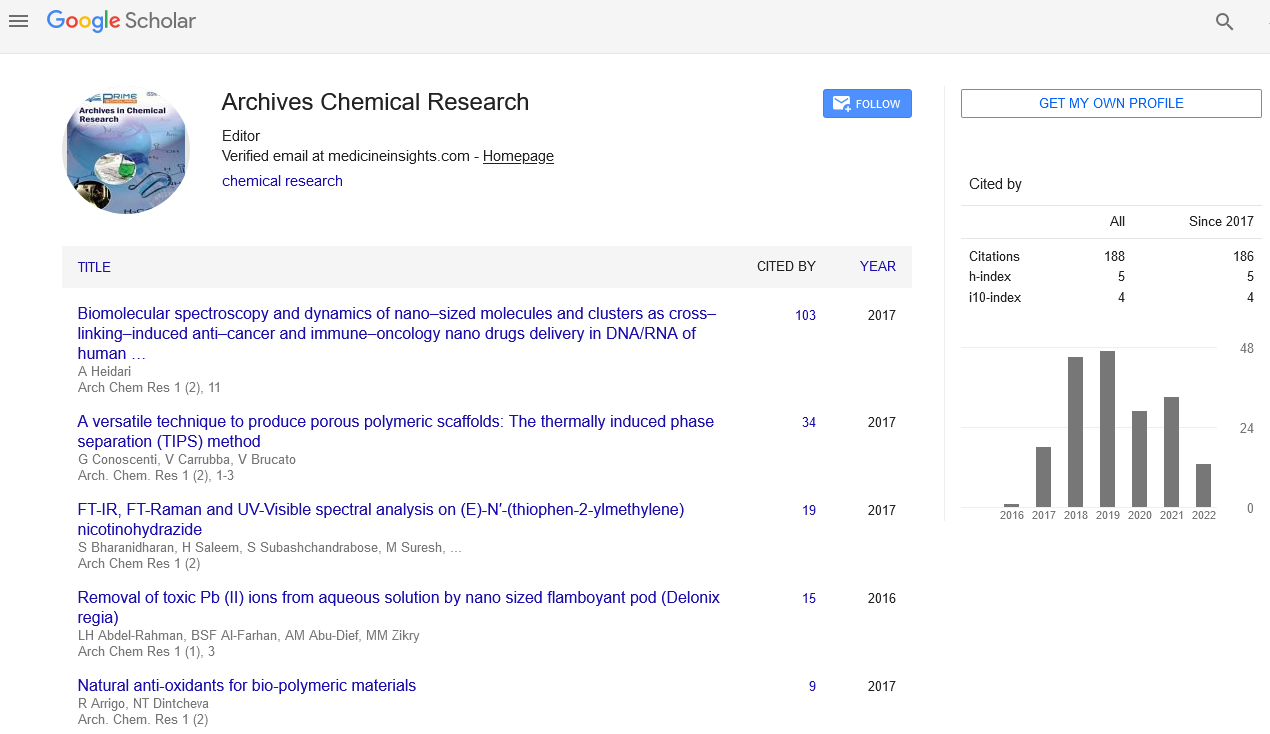Short Communication - (2024) Volume 8, Issue 2
Exploring NMR Spectroscopy: A Window into Molecular Structure
Lily Lewis*
Department of Organic Chemistry, University of Cumbria, United Kingdom
*Correspondence:
Lily Lewis,
Department of Organic Chemistry, University of Cumbria,
United Kingdom,
Email:
Received: 29-May-2024, Manuscript No. IPACRH-24-20305;
Editor assigned: 31-May-2024, Pre QC No. IPACRH-24-20305 (PQ);
Reviewed: 14-Jun-2024, QC No. IPACRH-24-20305;
Revised: 19-Jun-2024, Manuscript No. IPACRH-24-20305 (R);
Published:
26-Jun-2024, DOI: 10.35841/2572-4657.8.02.12
Introduction
Nuclear Magnetic Resonance (NMR) spectroscopy is a powerful
analytical technique used to determine the structure, dynamics,
reaction state, and chemical environment of molecules. It
leverages the magnetic properties of certain atomic nuclei
and provides detailed information about the structure of
organic compounds, making it indispensable in chemistry,
biochemistry, and medical diagnostics. NMR spectroscopy
is based on the magnetic properties of atomic nuclei. When
these nuclei are placed in a strong external magnetic field, they
align with or against the field. This alignment creates discrete
energy levels. When a sample is exposed to radiofrequency
(RF) radiation, nuclei in the lower energy state can absorb
this energy and transition to the higher energy state. This
process is called resonance. The specific frequency at which
this absorption occurs is called the resonance frequency and
is dependent on the strength of the magnetic field and the
magnetic environment of the nuclei. The resonance frequency
of a nucleus is influenced by its electronic environment,
leading to slight shifts in the resonance frequencies of different
nuclei within a molecule. This is known as the chemical shift.
The chemical shift provides information about the electronic
environment surrounding the nuclei, helping to deduce the
structure of the molecule [1,2].
Description
Nuclei can interact with adjacent nuclei through spin-spin
coupling, which splits NMR signals into multiples. The pattern
of these multiples and the coupling constants (measured in
Hertz) give insights into the number of adjacent nuclei and
their spatial relationships, aiding in the determination of the
molecule’s structure. Several NMR techniques are utilized
to extract different types of information from a sample This
is the most basic form, providing a spectrum with peaks
corresponding to the chemical shifts of the nuclei in the
sample Two-dimensional NMR techniques, such as COSY
(Correlation Spectroscopy), NOESY (Nuclear Over Hauser Effect
Spectroscopy), and HSQC (Heteronuclear Single Quantum
Coherence), provide more detailed information about the
molecular structure. These techniques can correlate signals
between nuclei through direct bonding or through-space
interactions, helping to map out the entire structure of the
molecule. This technique is used for studying solids, offering
insights into the structure and dynamics of solid materials.
Magic angle spinning (MAS) is often employed to average out
anisotropic interactions, leading to high-resolution spectra.
NMR is invaluable in elucidating the structures of proteins,
nucleic acids, and other biomolecules in solution. It provides
insights into their dynamic behavior and interactions, which
are crucial for understanding biological processes and
designing drugs. NMR is routinely used to determine the
structures of organic compounds. It helps chemists confirm
the identity and purity of synthesized compounds and study
reaction mechanisms. Magnetic Resonance Imaging (MRI) is a
medical application of NMR. MRI uses the principles of NMR to
create detailed images of soft tissues in the body, aiding in the
diagnosis and monitoring of diseases. NMR is used to study the
composition, structure, and dynamics of polymers, glasses, and
other materials. It provides information on molecular mobility,
phase transitions, and chemical composition. The field of
NMR spectroscopy continues to evolve with advancements in
technology and methodology. High-field NMR spectrometers
offer better resolution and sensitivity, enabling the study of
larger and more complex molecules. Cryogenically cooled
probes and Dynamic Nuclear Polarization (DNP) techniques
are enhancing sensitivity, allowing for the detection of lowabundance
species and faster data acquisition [3,4].
Conclusion
Moreover, the integration of NMR with other analytical
techniques, such as mass spectrometry and X-ray crystallography,
provides a more comprehensive understanding of molecular
systems. Computational methods and machine learning
are also being increasingly employed to interpret complex NMR data and predict spectra from molecular structures.
In conclusion, NMR spectroscopy is a versatile and powerful
tool that provides detailed insights into molecular structures
and dynamics. Its applications span numerous scientific
disciplines, driving advancements in research and technology.
As innovations continue to emerge, NMR spectroscopy will
remain at the forefront of molecular analysis and discovery.
Acknowledgement
None.
Conflict Of Interest
The author’s declared that they have no conflict of interest.
References
- Coley CW, Thomas DA, Lummiss JAM, Jaworski JN, Breen CP, et al. (2019) A robotic platform for flow synthesis of organic compounds informed by AI planning. Science. 365(6453): eaax1566.
[PubMed] [Crossref] [Google Scholar]
- Greenaway RL, Jelfs KE, Spivey AC, Yaliraki SN, (2023) From alchemist to AI chemist. Nat Rev Chem. (8):527-528.
[PubMed] [Crossref] [Google Scholar]
- Roch LM, Häse F, Kreisbeck C, Tamayo-Mendoza T, Yunker LPE, et al. (2018) Aspuru-Guzik ChemOS: Orchestrating autonomous experimentation. Sci Robot. 3(19): eaat5559.
[PubMed] [Crossref] [Google Scholar]
- H. Zhu (2020) Big data and Artificial Intelligence modeling for drug discovery. Annu Rev Pharmacol Toxicol. 60:573-589.
[PubMed] [Crossref] [Google Scholar]
Citation: Lewis L (2024) Exploring NMR Spectroscopy: A Window into Molecular Structure. Arch Chem Res. 8:12.
Copyright: © 2024 Lewis L. This is an open-access article distributed under the terms of the Creative Commons Attribution License, which permits unrestricted use, distribution, and reproduction in any medium, provided the original author and source are credited.

